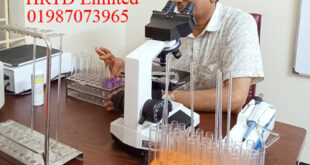Antibiotic Sensitivity Test
Antibiotic Sensitivity Test. Mobile Phone Number 01987073965, 01797522136. An antibiotic sensitivity test, also known as an antibiotic susceptibility test, determines if bacteria or fungi are susceptible to particular antibiotics, helping to find the most effective treatment for an infection. The process involves collecting a sample (like a urine or blood culture), growing the microorganisms in a lab, and then exposing them to discs or solutions containing different antibiotics. The results show which antibiotics inhibit bacterial growth (sensitive) and which do not (resistant), which is critical for managing antibiotic-resistant infections.
Why are these tests needed?
- Antibiotic Resistance: Infections caused by bacteria or fungi can become resistant to certain antibiotics, making them difficult to treat.
- Effective Treatment: The test helps doctors choose the right antibiotic to fight the specific infection, improving recovery time and reducing side effects.
- Serious Infections: It is particularly important for severe infections like MRSA (Methicillin-resistant Staphylococcus aureus) or C. diff (Clostridioides difficile).
Common Types of Tests
- 1. Disk Diffusion (Kirby-Bauer) Method:
- A bacterial or fungal culture is spread evenly on a petri dish.
- Discs impregnated with different antibiotics are placed on the agar surface.
- After incubation, clear areas, called zones of inhibition, appear around the discs where the antibiotic stopped the organism’s growth.
- The diameter of these zones is measured to determine the organism’s sensitivity.
- 2. Dilution Methods:
- These methods determine the Minimum Inhibitory Concentration (MIC), the lowest concentration of an antibiotic that prevents microbial growth.
- The microorganism is exposed to a series of decreasing antibiotic concentrations in tubes.
Sample Collection Methods
- Blood Culture: A small amount of blood is taken from a vein.
- Urine Culture: A sterile urine sample is collected.
- Wound Culture: A swab is used to collect a sample from a wound site.
- Sputum or Throat Culture: Samples are collected from the lungs or throat.
Results Interpretation
Based on the zone sizes (in disk diffusion) or the MIC (in dilution methods), the organism’s response is categorized as:
- Sensitive: The antibiotic is effective in inhibiting growth.
- Resistant: The antibiotic is not effective.
- Intermediate: The bacteria have some susceptibility, but it’s not ideal or may require higher doses.
Disk Diffusion Method
The Disk Diffusion (Kirby-Bauer) Method is a standardized laboratory test that determines a bacterium’s susceptibility to various antimicrobial compounds by measuring the diameter of a clear “zone of inhibition” around an antibiotic-impregnated disc placed on an inoculated agar plate. The procedure involves preparing a microbial “lawn” on a Mueller-Hinton agar plate, placing antibiotic discs on the plate, incubating it, and then measuring the zone of inhibition to classify the bacteria as resistant, intermediate, or susceptible to the antibiotic, using established interpretive criteria from organizations like the CLSI.
Procedure of Disk Diffusion Method
- 1. Prepare the Inoculum:Suspend the isolated bacterial colonies in a liquid broth to achieve a turbidity matching a 0.5 McFarland standard.
- 2. Inoculate the Agar Plate:Using a sterile cotton swab, streak the standardized bacterial suspension across the entire surface of a Mueller-Hinton agar plate to create a uniform “lawn” of bacteria.
- 3. Place the Discs:Using a sterile technique and forceps, place standardized antimicrobial-impregnated discs onto the surface of the agar plate, ensuring even distribution and good contact with the agar.
- 4. Incubate the Plate:Invert the inoculated plate and incubate it at 35°C for 16 to 18 hours.
- 5. Measure the Zones of Inhibition:After incubation, measure the diameter of the clear zone around each disc where there is no bacterial growth (the zone of inhibition) using a ruler or caliper.
- 6. Interpret the Results:Compare the measured zone diameters to the interpretive criteria, or “breakpoints,” found in standards like the CLSI M100 document, to determine if the bacterium is resistant, intermediate, or susceptible to the specific antimicrobial agent.
Materials Required for Disk Diffusion Method
- Mueller-Hinton agar plates
- Standardized bacterial suspension (0.5 McFarland)
- Antimicrobial-impregnated filter paper discs
- Sterile cotton swabs
- Forceps or a disc dispensing apparatus
- Ruler or sliding caliper
- CLSI M100 interpretive guide
Dilution Method
Dilution involves decreasing a solution’s concentration by adding more solvent. There are two primary methods: Single Dilution, where a fixed ratio of solute to solvent is added to a final volume, and Serial Dilution, a step-by-step process of making multiple dilutions from a stock solution. To perform a single dilution, use the formula C₁V₁ = C₂V₂ to determine the required volumes, then add the measured stock solution to the calculated solvent volume to reach the final volume. For serial dilution, prepare dilution blanks, transfer a precise amount of the stock or previous dilution to the first blank, mix, then transfer a precise amount from that tube to the next blank to create a series of progressively weaker solutions.
Dilution Methods
- Single Dilution:A single step of adding solvent to a stock solution to reach a specific, less concentrated volume.
- Serial Dilution:A multi-step process where a portion of one solution is diluted to create the next solution, resulting in a series of dilutions. Common types include:
- Logarithmic Dilution: Each successive dilution results in a constant proportional decrease in concentration, like doubling or decimating dilutions.
- Broth Dilution: Used in microbiology for antimicrobial susceptibility testing, where antimicrobials are serially diluted in a broth.
- Agar Dilution: Another method for antimicrobial susceptibility testing, where dilutions of antimicrobials are incorporated into agar before inoculation.
Procedure for a Single Dilution Method
- 1. Calculate Dilution:Use the formula C₁V₁ = C₂V₂, where C₁ is the initial concentration, V₁ is the initial volume, C₂ is the final concentration, and V₂ is the final volume.
- 2. Measure Solute:Measure the required volume of the concentrated stock solution (V₁).
- 3. Add Solvent:Add a measured amount of the solvent (e.g., water) to a volumetric flask or appropriate container.
- 4. Combine and Mix:Add the stock solution to the solvent and fill the container to the desired final volume (V₂).
Procedure for a Serial Dilution (Microbiology Example)
- 1. Prepare Dilution Blanks:Place a precise volume of the chosen diluent (e.g., sterile water, culture medium) into several labeled tubes.
- 2. Inoculate First Tube:Transfer a specific, measured volume of the concentrated sample (e.g., bacterial suspension) into the first tube containing the diluent.
- 3. Mix Thoroughly:Mix the contents of the tube to ensure the sample is evenly dispersed.
- 4. Transfer to Next Tube:Pipette a precise volume from the first tube into the second tube of dilution blanks.
- 5. Repeat:Continue this process for each subsequent tube, creating a series of dilutions, with each step yielding a more dilute solution.
- 6. Maintain Aseptic Technique:Throughout the process, use sterile equipment and follow aseptic techniques to prevent contamination.
 Pathology Training Institute in Bangladesh Best Pathology Training Institute in Bangladesh
Pathology Training Institute in Bangladesh Best Pathology Training Institute in Bangladesh



